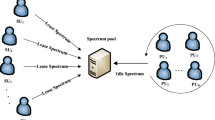Abstract
Dynamic spectrum leasing (DSL) has been proposed as a solution for better spectrum utilization. Most of the work focused on non-cooperative game to model primary/secondary users interactions in DSL approach. Some others introduced cooperative game just for secondary users (SUs). In this paper, both primary users (PUs) and SUs incentives and level of satisfactions are considered. Nash bargaining is developed with both PUs and SUs as bargainers. A simple pricing approach is introduced which makes the proposed method practically feasible. On one hand, SUs adjust their power regarding to price and tolerable interference which are announced by PU. On the other hand, PU adjusts its tolerable interference to maximize its profit. Simulation results verify the viability of proposed method.





Similar content being viewed by others
Notes
This SINR represents the highest possible value. The secondary system could utilize the lower amount. The following discussion clears the real attained SINR value.
Independence of irrelevant alternatives is related to fairness issue which is outside the scope of this paper.
References
Simeone, O., Stanojev, I., Savazzi, S., Bar-Ness, Y., Spagnolini, U., & Pickholtz, R. (2008). Spectrum leasing to cooperating secondary ad hoc networks. IEEE Journal on Selected Areas in Communications, 26(1), 203–213.
Yi, Y., Zhang, J., Zhang, Q., & Jiang, T. (2011). Spectrum leasing to multiple cooperating secondary cellular networks. In Proceedings of the IEEE ICC11 (p. 15).
Jayaweera, S., & Li, T. (2009). Dynamic spectrum leasing in cognitive radio networks via primary-secondary user power control games. IEEE Transactions on Wireless Communications, 8(6), 3300–3310.
Alptekin, G. I., & Bener, A. B. (2011). Spectrum trading in cognitive radio networks with strict transmission power control. European Transactions on Telecommunications, 22(6), 282–295.
Jayaweera, S., Vazquez-Vilar, G., & Mosquera, C. (2010). Dynamic spectrum leasing: A new paradigm for spectrum sharing in cognitive radio networks. IEEE Transactions on Vehicular Technology, 59(5), 2328–2339.
Hakim, K., Jayaweera, S., El-howayek, G., & Mosquera, C. (2010). Efficient dynamic spectrum sharing in cognitive radio networks: Centralized dynamic spectrum leasing (C-DSL). IEEE Transactions on Wireless Communications, 9(9), 2956–2967.
El-howayek, G., & Jayaweera, S. (2011). Distributed dynamic spectrum leasing (D-DSL) for spectrum sharing over multiple primary channels. IEEE Transactions on Wireless Communications, 10(1), 55–60.
Yang, C., Li, J., & Tian, Z. (2010). Optimal power control for cognitive radio networks under coupled interference constraints: A cooperative game-theoretic perspective. IEEE Transactions on Vehicular Technology, 59(4), 1696–1706.
Bayat, S., Louie, R. H. Y., Vucetic, B., & Li, Y. (2013). Dynamic decentralised algorithms for cognitive radio relay networks with multiple primary and secondary users utilising matching theory. Transactions on Emerging Telecommunications Technologies, 24(5), 486–502.
Murawski, R., & Ekici, E. (2011). Utilizing dynamic spectrum leasing for cognitive radios in 802.11-based wireless networks. Computer Networks, 55(5), 2646–2657.
Bourdena, A., Pallis, E., Kormentzas, G., & Mastorakis, G. (2013). Efficient radio resource management algorithms in opportunistic cognitive radio networks. Transactions on Emerging Telecommunications Technologies. doi:10.1002/ett.2687.
Huang, J., Berry, R., & Honig, M. (2006). Auction-based spectrum sharing. Mobile Networks and Applications, 11, 405–418.
Chen, L., Iellamo, S., Coupechoux, M., & Godlewski, F. (2010). An auction framework for spectrum allocation with interference constraint in cognitive radio networks. In Proceedings of the IEEE INFOCOM (p. 19).
Wu, Y., Wang, B., Liu, K., & Clancy, T. (2009). A scalable collusion-resistant multi-winner cognitive spectrum auction game. IEEE Transactions on Communications, 57(12), 3805–3816.
Adian, G. M., & Aghaeinia, H. (2013). An auction-based approach for spectrum leasing in cooperative cognitive radio networks: When to lease and how much to be leased. Wireless Networks, 19(7), 3805–3816.
Osborne, M., & Rubinstein, A. (1990). Bargaining and markets. New York: Academic Press Inc.
Attar, A., Nakhai, M., & Aghvami, A. (2009). Cognitive radio game for secondary spectrum access problem. IEEE Transactions on Wireless Communications, 8(4), 2121–2131.
Suris, J., DaSilva, L., Han, Z., MacKenzie, A., & Komali, R. (2009). Asymptotic optimality for distributed spectrum sharing using bargaining solutions. IEEE Transactions on Communications, 8(10), 5225–5237.
Ni, Q., & Zarakovitis, C. C. (2012). Nash bargaining game theoretic scheduling for joint channel and power allocation in cognitive radio systems. IEEE Journal on Selected Areas in Communications, 30(1), 70–81.
Guan, X., Wang, X., Ma, K., Liu, Z., & Han, Q. (2014). Spectrum leasing based on Nash Bargaining Solution in cognitive radio networks. Telecommunication Systems. doi:10.1007/s11235-013-9860-5.
Toroujeni, S. M. M., Sadough, S. M., & Ghorashi, S. A. (2012). On time-frequency resource leasing in cognitive radio networks. Wireless Personal Communication. doi:10.1007/s11277-011-0274.
Saraydar, C., Mandayam, N., & Goodman, D. (2002). Efficient power control via pricing in wireless data networks. IEEE Transactions on Communications, 50(2), 291–303.
Azimi, S. M. (2014). Pareto optimal primarysecondary user dynamic spectrum leasing game. Electronics Letters, 50(12), 874–876.
Zhao, Y., Mao, S., Neel, J., & Reed, J. (2009). Performance evaluation of cognitive radios: Metrics, utility functions, and methodology. Proceeding of IEEE, 97(4), 642–659.
Cao, X., Shen, H., Milito, R., & Wirth, P. (2002). Internet pricing with a game theoretical approach: Concepts and examples. IEEE/ACM Transactions on Networking, 10(2), 208–216.
Boyd, S., & Vandenberghe, L. (2004). Convex optimization. Cambridge: Cambridge University Press.
Bertsekas, D. (1999). Nonlinear programming. Nashua, NH: Athena Scientific.
Saad, W., Han, Z., Debbah, M., Hjrungnes, A., & Basar, T. (2009). Coalitional game theory for communication networks. IEEE Signal Processing Magazine, 26(5), 77–97.
Myerson, R. B. (1991). Game theory, analysis of conflict. Cambridge, MA: Harvard University Press.
Author information
Authors and Affiliations
Corresponding author
Rights and permissions
About this article
Cite this article
Azimi, S.M., Manshaei, M.H. & Hendessi, F. Cooperative primary–secondary dynamic spectrum leasing game via decentralized bargaining. Wireless Netw 22, 755–764 (2016). https://doi.org/10.1007/s11276-015-0999-8
Published:
Issue Date:
DOI: https://doi.org/10.1007/s11276-015-0999-8




